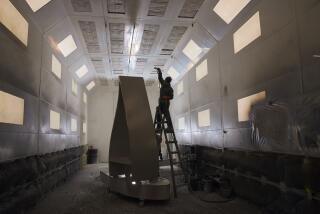Power Project Raises Students’ Energy Levels
- Share via
Susan Sragovicz, property manager for First Capital Life Insurance’s six buildings in San Diego, believes that too often, “There’s little relationship between what you do in college and what you do in the real world.”
That’s why First Capital has joined a growing number of companies providing financial support and engineering expertise to the Energy Engineering Institute at San Diego State University.
Institute students, mostly seniors selected from SDSU’s mechanical engineering department, recently designed a thermal-energy storage project for one of First Capital’s office buildings. Using equipment and engineering advice from First Capital, the students “surveyed the building, designed a system and tried to do an economic analysis of a pay-back schedule,” Sragovicz said.
First Capital doesn’t plan to install such a device because of the costs involved, but Sragovicz said the institute’s projects are valuable because it “gets students out of the classroom and the theoretical world and into the real world.”
SDSU students also have worked on energy-related projects for San Diego Gas & Electric, Southern California Edison, IRT Corp. ECD Corp., Verle Williams & Associates, the architect of St. Vincent de Paul Society’s emergency housing shelter, and the San Diego-based Alternative Energy Institute.
And the institute recently won the U.S. Department of Energy’s 1987 National Energy Innovation Award for work done to help San Diego companies solve various problems.
A Real Life Case of What Happens
Students who are selected to work on institute projects “see a specific real life case of what happens” instead of concentrating on theory or laboratory experiments, according to Verle Williams, owner of Verle Williams & Associates, a San Diego-based energy consulting firm.
SDSU’s mechanical engineering department founded the institute in early 1986 to help students who want to enter energy management careers. The institute concentrates on projects that companies might be interested in but that probably wouldn’t be economical without the students’ free labor.
During one recent project, institute members painted the roof of Williams’s office building with a reflective material that reduces heat build-up inside. They also installed monitoring devices that measured energy savings in different parts of the building.
That practical application of a theory learned in the classroom “was better than having them sit in a classroom with a heat lamp over a dark surface and a light surface,” Williams said. “It helped them not only in terms of remembering the theory . . . (but) some day they’ll be able to think back and apply the knowledge they’ve learned.”
Donald H. Lark, managing director of the institute, said projects are designed to emphasize the fact that “there are non-technical things that are as important as the technical things.
A Series of Legal and Regulatory Barriers
“We want them to do the whole thing, from getting the necessary (regulatory) permits to fighting the bureaucracy,” said Lark, who joined the institute in 1986 after a 35-year career as an industrial engineer. “They’ll be more marketable after graduation if they’ve done that sort of thing.”
Institute students ran into a series of legal and regulatory barriers during a recent project involving an experimental co-generation unit. Students used theory learned in the classroom to solve technical problems surrounding the co-generation unit.
But students also “had to deal with (SDG&E;), state regulators and even SDSU’s attorneys, who were worried about liability problems,” according to SDSU senior Carlos Aylwin.
“The one problem with hiring a (recent) graduate is that they rarely have any field experience, and (the energy management) business requires a lot of experience,” Williams said. “This program is . . . their big introduction to industry.”
Industry has shown strong support for the institute, according to Halil M. Guven, an assistant professor of mechanical engineering who also serves as director of the institute. “We’ve got more requests from industry than we can handle,” Guven said.
The institute has received about $60,000 in cash from the industry since its establishment in early 1986, Guven said. SDG&E;, the institute’s heaviest contributor, has pledged $125,000 over a five-year period.
Equally important are the man-hours and equipment that various companies in Southern California have donated. SDG&E; has estimated the value of time spent by its employees at $10,000, Guven said.
Despite those donations, the institute needs more money to buy equipment for a laboratory being established in a 40-year-old building on the SDSU campus.
“We couldn’t open a (viable) business with the kind of equipment we’ve got here,” Lark complained. “But we have to make sure that students who walk out of here aren’t being trained on 1950s-era equipment for a 1990s atmosphere.”
Figures Deceptive
The institute has a budget of about $40,000, Guven said. That figure is deceptive because Lark and a secretary are the only paid employees at the institute. Guven and industry volunteers are not paid for their time.
Lark and Guven said publicity surrounding the Department of Energy award is an honor and has helped to boost the institute’s credibility, but they are more interested in how the agency will respond to a $200,000 grant proposal that the university will submit later this week. The institute needs the money to complete work on a project that is expected to demonstrate that an experimental co-generation system is economically viable.
Experimental Lighting
Another group of students has monitored experimental lighting voltage regulators that were developed by ECD Corp., a small, San Diego-based electronics company. The devices are designed to reduce electric bills by more accurately regulating the amount of power flowing through light bulbs.
During recent months, students at the institute also have worked with Southern California Edison to analyze the efficiency of an “instantaneous” electric water heater.
More to Read
Inside the business of entertainment
The Wide Shot brings you news, analysis and insights on everything from streaming wars to production — and what it all means for the future.
You may occasionally receive promotional content from the Los Angeles Times.










